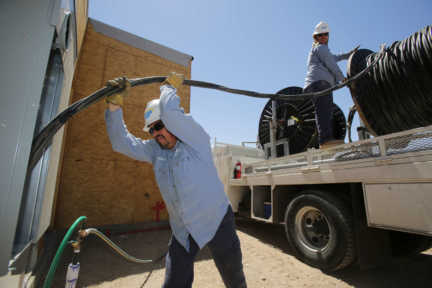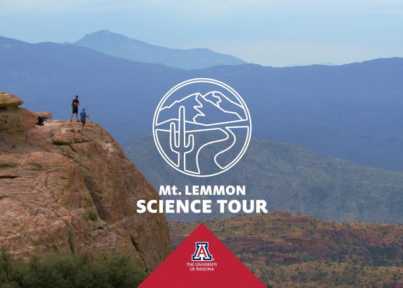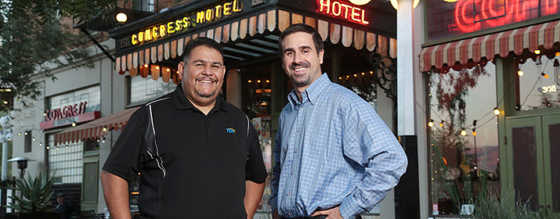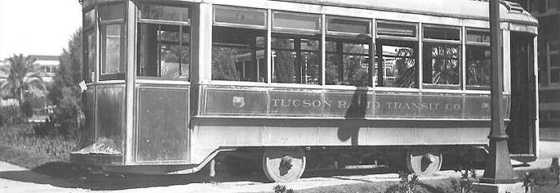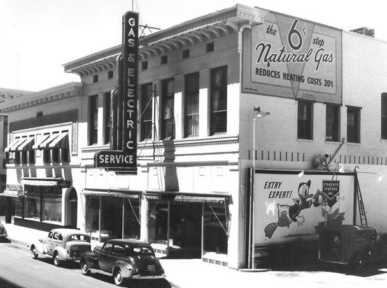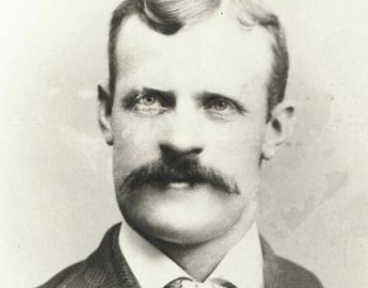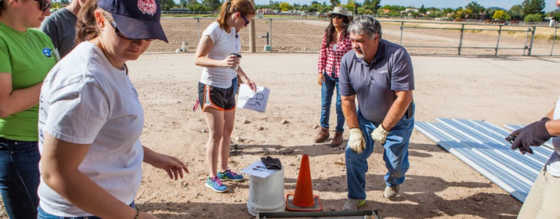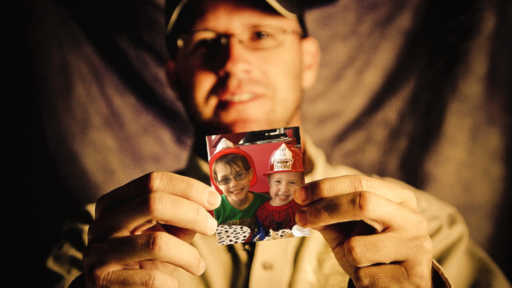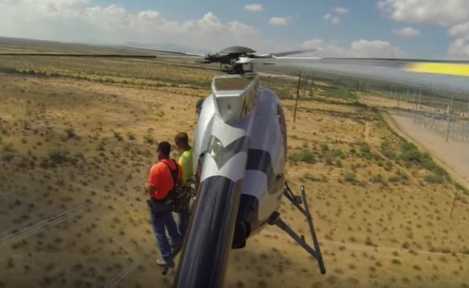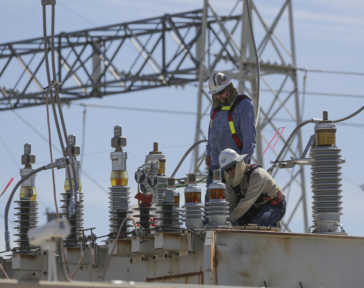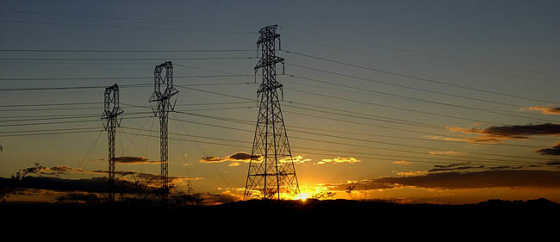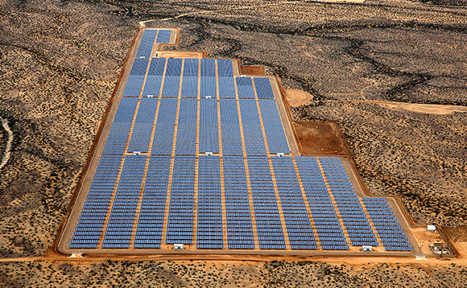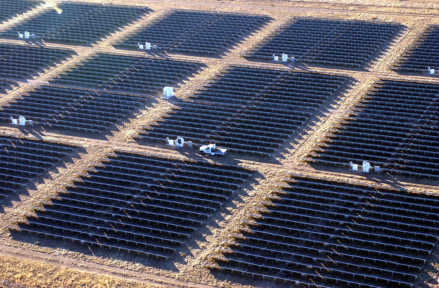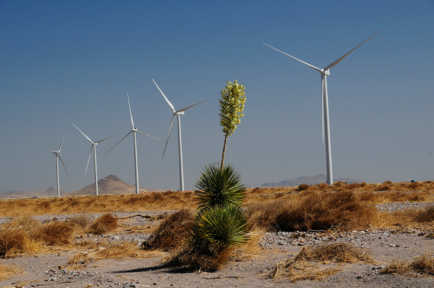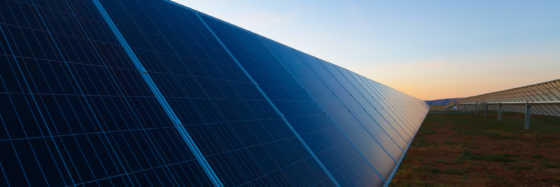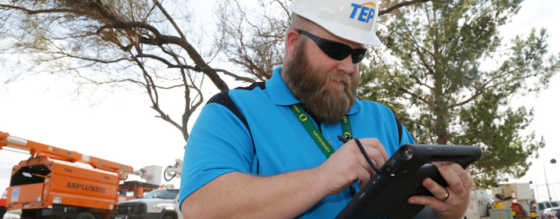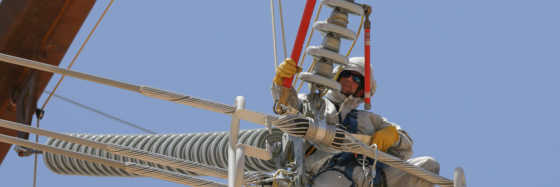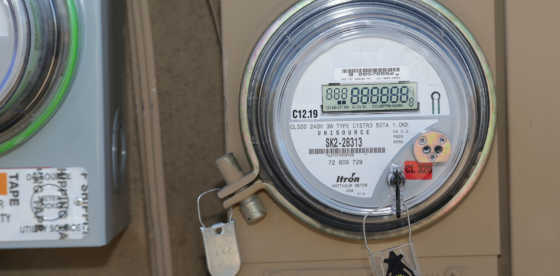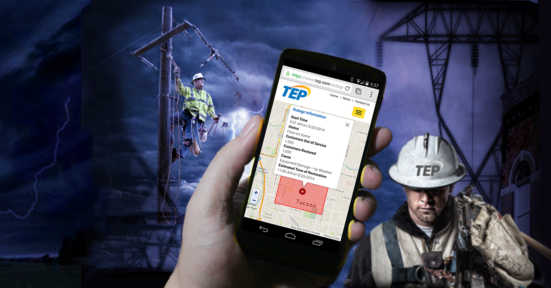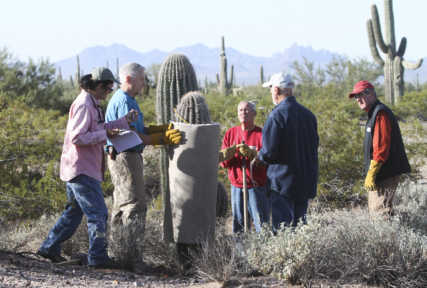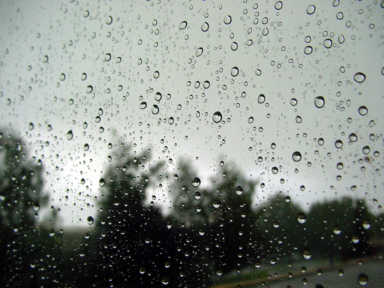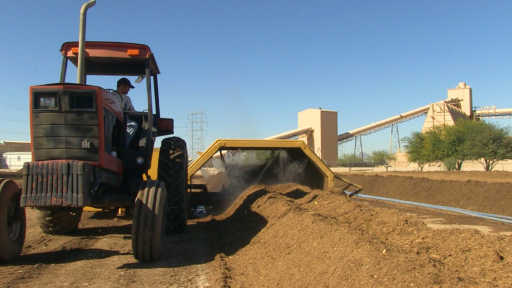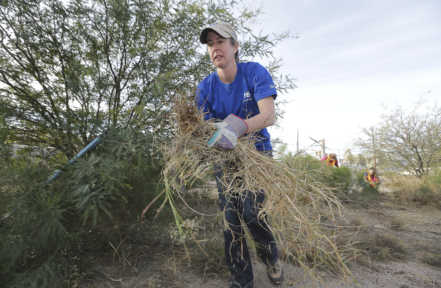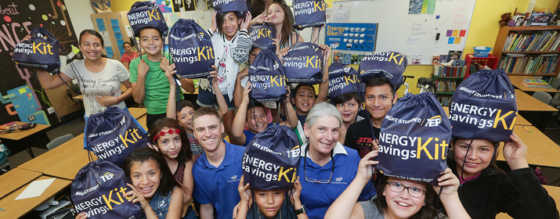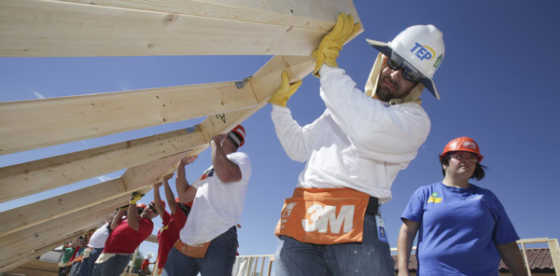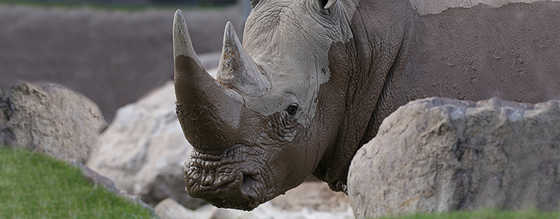
125 things you didn't know about TEP
Back in 1892, a group of local businessmen banded together to illuminate the dusty streets of territorial Tucson. One hundred and twenty-five years later, Tucson Electric Power is still powering our community's growth. A system that began with 80 poles and a single steam engine now provides safe, reliable and affordable energy to more than 417,000 residents in the Tucson metropolitan area. Our company continues to seek innovative solutions for customers as we build a sustainable energy future for Southern Arizona. Read about TEP's history, and see below for 125 things you might not know about your electric utility.
Commitment to customers
TEP can trace its history back to Oct. 28, 1892, after business leaders in territorial Tucson met to organize the Tucson Electric Light and Power Company and elect local merchant Albert Steinfeld as its first president. The Arizona Weekly Citizen later declared the company, “…is pushing things to a successful conclusion and Tucson will hail the result with delight.”
TEP’s rates have been remarkably stable, rising at less than the rate of inflation over the last two decades.
TEP will never call you and ask you to pay an overdue bill with a cash card to avoid disconnection. But a scammer might.
TEP can de-energize or reconfigure electrical equipment at or near your work site to prevent injury and avoid outages.
TEP provides rebates that can reduce the cost of a new energy efficient air conditioner by up to $850 when you purchase a qualified unit from a TEP Efficient Home Program participating contractor.
TEP doesn’t provide electric service on Mt. Lemmon, but we did help the University of Arizona create a mobile app that provides a scientific tour of the mountain.
Moving? You can start, stop or transfer your TEP service online using My Account.
TEP’s BrightEE awards recognize businesses that save energy and improve the environment – making us the only local business that rewards customers for buying less.
If you’ve misplaced one of the advertising flyers delivered with your TEP bill, we know where it is.
TEP helped The Salvation Army build an energy efficient Hospitality House that provides emergency shelter, transitional housing and office space. The LEED Silver-certified building on Main Avenue just south of Speedway Boulevard replaces a 50-year-old facility and assists the agency in providing more than 50,000 meals annually in Tucson.
Tucson’s historic Hotel Congress has been around nearly as long as TEP, but its air conditioners are brand new – and were discounted through a TEP energy efficiency program.
TEP connects more than power. If you’re moving in, we also can set up your telephone, home security, Internet and television services all at once using Allconnect.
In 1925, the Tucson Gas, Electric Light and Power Company (now called TEP) opened a home service department to help homemakers with cooking problems, provide recipes and assist in planning parties.
More than 7,000 TEP customers volunteer to pay a little more each month so that limited-income customers in financial distress can pay less. Care to join them? Become a TEP HEERO.
Up to 10 percent of the power TEP provides to homes is wasted by “energy phantoms” – phone chargers, power strips and other devices that use energy even when they’re not being used.
TEP crews face many obvious risks on the job – and some less obvious ones. Unrestrained dogs have injured many utility employees during service appointments.
Our company
You can learn what it’s like to be a TEP employee and apply for one of our many opportunities by visiting our Career Center.
TEP was named Employer of the Year in 2016 by Linkages for its efforts to hire individuals with disabilities.
Highly trained troublemen are TEP’s first-responders during power outages and other emergencies.
More than one out of every 10 TEP employees are military veterans, and we’re working hard to hire more.
TEP once owned and operated Tucson Rapid Transit, the company later purchased by the City of Tucson and transformed into Sun Tran. Tucson Rapid Transit launched the city’s first electric streetcar in 1906, replacing horse-drawn streetcars. Today, TEP is proud to power the city’s modern electric streetcar.
In 1937, company employees formed a union that became Local 1116 of the International Brotherhood of Electrical Workers. Today, two-thirds of TEP employees are represented by the IBEW.
TEP’s safe, reliable service depends in part on valuable services provided by workers from the Beacon Group, which provides employment opportunities to people with disabilities.
Before selling its natural gas distribution business to Southwest Gas Corporation in 1979, Tucson Electric Power was known as Tucson Gas & Electric Co.
The current board of TEP’s parent company is led by University of Arizona basketball legend Robert A. Elliott, President of Elliott Accounting.
Frank E. “Red” Russell wasn’t just a company founder and its first manager. He also served on the Tucson City Council.
The man responsible for TEP’s power plants spends some of his spare time building outhouses in Bolivia as a mentor for the University of Arizona chapter of Engineers Without Borders.
Each one of TEP’s 150 journeyman electricians have trained for more than 7,800 hours and passed a series of challenging tests to ensure they’re ready to safely maintain our local energy grid.
David Hutchens is the first homegrown CEO in TEP’s history, having worked his way up to his current position over nearly 20 years with the company.
TEP partners with Pima Community College on a program that introduces local talent to the energy industry and the many careers at TEP.
TEP’s Carmine Tilghman has been recognized as a national Solar Power Player Solar Champion by the Solar Electric Power Association, a solar industry trade association.
After beginning life in 1892 as a “startup” owned by local businessmen, the company that became Tucson Electric Power was sold in 1901 for $35,000 cash to a Denver businessman who also assumed $15,000 in debt. More than a century later, TEP and its parent company were acquired by Canadian-based Fortis Inc. in August 2014 for $4.5 billion, including the assumption of $2 billion in debt.
Safe, reliable service
While reliability is critical, safety remains the top priority of every TEP employee.
Sometimes, providing safe, reliable service means going head-to-head with colonies of bees.
One of the most valuable tools used to build TEP transmission lines is a helicopter.
TEP’s Customer Care team often answers more than 500 customer calls during a single monsoon storm.
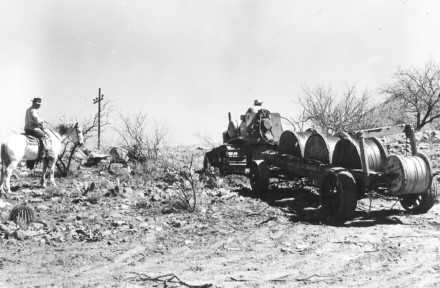
37. World War II Expansion
TEP significantly expanded facilities in the 1940s as Southern Arizona became a major military and war production center in World War II. Expanded facilities provided service to a primary flight school in Marana, the heavy bomber base at Davis-Monthan, Consolidated-Vultee Aircraft modification center at the municipal airport, the Ryan School of Aeronautics and the U.S. Army base at Fort Huachuca.

38. Anticipating Your Needs
Because electricity is a real-time product, whatever you use is being generated somewhere on the grid at that very moment. That’s why TEP and other utilities must plan carefully to anticipate customers’ needs, which can be affected by the weather, economic factors and other considerations.

39. Peak Usage: 5-7 p.m.
While Tucson’s summer heat drives energy use higher, TEP’s system usage typically peaks just as temperatures are starting to cool down: between 5 p.m. and 7 p.m., when our customers are coming home from work, dialing down their thermostats and turning on appliances.
To maintain reliable service, TEP conducts critical circuit patrols to identify vulnerable equipment and replace it before it breaks, not after.
It takes months to move a 25,000-pound transmission tower just 150 feet – if you include the time spent to plan this critical operation. (But you’ll only need two minutes to watch it happen.)
TEP won an international reliability award for developing a system to predict when equipment will fail, giving us a chance to repair or replacing it before that happens.
Rubber gloves help keep our crews safe on the job. That’s why they’re tested regularly – just like other critical components of our local energy grid.
To ensure reliable service, TEP replaces two or three substation transformers every year. Each one costs about $3 million and takes more than a year to build.

45. Reliable Service
TEP’s service ranks among the most reliable in the nation based on industry metrics that measure the number and duration of sustained power outages experienced by customers.

46. Grid: By the Numbers
TEP’s modern grid includes 2,170 miles of high-voltage transmission lines, about 7,557 miles of lower-voltage distribution lines and more than 95,000 utility poles.
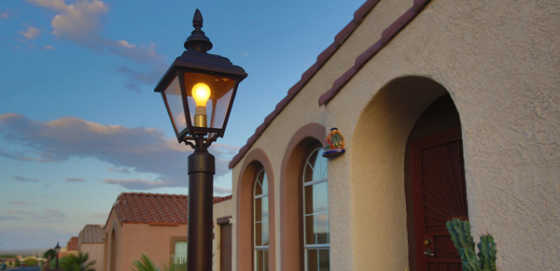
47. Underground Lines
Out of sight, out of mind: Almost two thirds of TEP’s distribution lines are located underground.
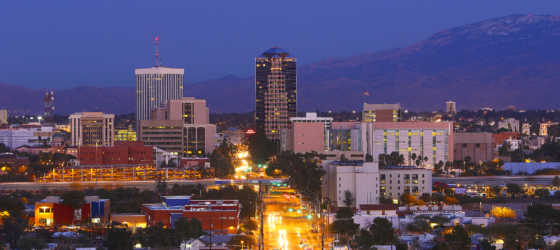
48. Broad Service Territory
TEP’s service territory spans 1,155 square miles – an area that exceeds the size of 30 countries and is a little smaller than the state of Rhode Island.

49. 5,000 Lightning Bolts
During one hour on a typical summer afternoon, TEP delivers an amount of energy equivalent to more than 5,000 lightning bolts.
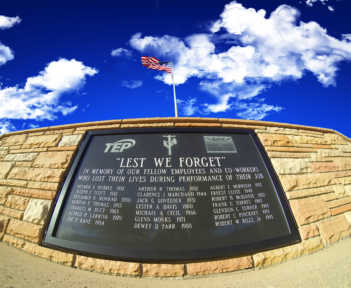
50. Lest We Forget
A memorial on our Irvington Road campus serves as a constant reminder of 21 TEP employees who lost their lives while on duty over the last eight decades. Most died from electric shock, but the two most recent deaths resulted from drunk driving accidents.
Cooling a typical Tucson home for a year requires about the same amount of energy exerted by all of the nearly 7,000 cyclists who participated in last year’s El Tour de Tucson.
How many homes can TEP reliably serve with solar energy? While we continue to expand our renewable energy resources, the real answer is zero – without constant backup and support from our modern electric grid and traditional energy resources.
TEP must build enough facilities to satisfy customers’ highest level of electric use, or “demand,” even if that capacity isn’t always needed. That’s why some of our pricing plans include a “demand charge” based on a customer’s highest energy use during a certain period of time. Without demand charges, usage-based rates would have to be set at much higher levels to recover service costs.

54. Regional Reliability
TEP’s energy grid is directly connected to similar systems that serve 12 western states and two Canadian provinces. These links provide our customers affordable access to energy resources that make our system more resilient and reliable.

55. Expansion in 1927
TEP gained national attention in 1927 for its plans to expand its generating resources. The purchase of a 3,750-horsepower Busch-Sulzer oil engine would make Tucson’s central plant the largest oil-fueled public utility power generator in the country.
Energizing your life
Since 2011, TEP has invested more than $100 million to expand cost-effective large-scale solar energy resources.
TEP’s largest local power plant runs entirely on a clean combination of natural gas and renewable resources.
You can check out our expanding portfolio of clean renewable resources on Google Maps.
You can go solar without adding panels to your home through our Bright Tucson Community Solar Program.
In 1904, TEP provided electricity for lighting on fixed price contracts that began at 13 cents per kilowatt hour (kWh). Today, more than a century later, we’re providing safe, reliable power for rates that average less than 12 cents per kWh.
TEP is recognized as an industry leader in renewable energy and has won multiple national awards for its expanding solar and wind energy resources.
TEP employs sophisticated weather forecasting to predict how solar and wind installations will perform from day to day, helping us maintain reliable service in any weather.
We’re partnering with the UA to study and identify the optimal integration of renewable energy technology with traditional energy resources.
TEP’s community scale solar resources have a combined capacity of 247 megawatts. That’s enough clean, green energy to power more than 52,000 homes for a year.
By 2030, TEP will be able to satisfy the annual electric needs of nearly 250,000 typical Tucson homes with clean renewable energy from large, cost effective community-scale wind and solar power systems.
TEP’s early street lighting contracts stated expressly that the lights didn't have to be turned on when there was a full moon.
We have invested more than $1 billion since 2011 to maintain safe, reliable electric service for our customers.
TEP plans to supply at least 30 percent of its power from renewable resources by 2030 – exceeding Arizona's requirement of 15 percent renewables by 2025.
Energy from small private solar arrays costs three to four times as much as the output of large, community-scale solar power systems.
In the early 1900s, the city of Tucson’s state of the art electrical system featured carbonized bamboo filament bulbs that glowed in more than 300 homes and businesses. Now TEP helps customers buy today’s latest and greatest bulbs – light emitting diodes, or LEDs.

71. Mesquite Power
TEP’s first generating resource was arguably also its first renewable generating resource. The steam engine built in the company’s downtown “power house” was fueled by mesquite logs, which could be considered a renewable biomass fuel by today’s standards.
TEP’s status as a solar energy leader dates back to at least 2004, when the solar array at its Springerville Generating Station produced more energy than any other photovoltaic array on the planet.
Driving on Interstate-10 near South Alvernon Way? Catch a glimpse of our AREVA solar power system, which uses concentrated sunlight to create superheated steam and generate electricity.
Ongoing innovation
TEP’s new mobile app allows you to pay a bill, report an outage and more with your Apple or Android device.
New technology helps TEP plan tree trimming projects that preserve the safety and reliability of the electric system.
TEP linemen can repair extra-high voltage lines without powering them down first using a “bare hand” method.
TEP partners with the UA Tech Park to test new and emerging solar energy technology.
Over the last 125 years, TEP has managed energy resources to match our customers’ electric use. Over the next 125 years, we’ll be helping customers manage their electric use to match existing resources, saving money and protecting our environment through targeted energy efficiency efforts.
In 1903 – the same year that the Wright brothers made their historic flight – company leaders pioneered the use of alternating current (AC) generators in Tucson’s local electrical system. Growing demand was threatening to exceed the capacity of the company’s direct current (DC) generators.
Smart thermostats from TEP are helping limited-income renters save energy and money.
Automated meters offer an accurate, affordable way to measure energy usage.
TEP is developing two large energy storage systems that will improve service reliability.
Power out? Use TEP’s outage map to find out the cause and the estimated restoration time.
We're working with local schools to develop and fund customized energy efficiency projects that protect our environment while preserving limited resources for classroom needs.
TEP’s future customers may be driving around in our power plants. Cars powered by fuel cells may someday produce energy that be shared through our evolving grid.
TEP is working with elected officials and other local leaders to develop innovative energy partnerships and new pricing plans that attract new businesses to Tucson. Our proposed economic development rate would provide temporary discounts for companies that bring new jobs and significant new investment to our community.
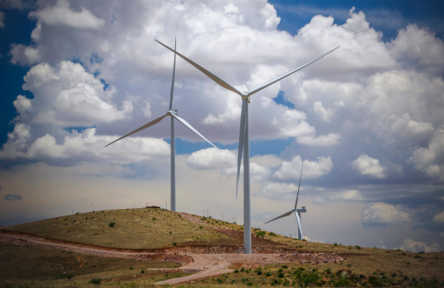
87. New Energy Technology
In coming decades, TEP will balance the intermittent output of our growing wind and solar energy portfolio with innovative energy technologies that may include flywheels, compressed air systems and reciprocating engines.
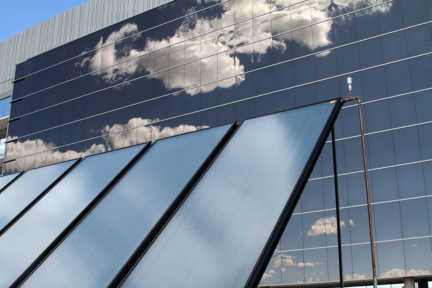
88. Microgrids
TEP is already planning for future “microgrids” that will integrate smart distribution equipment, energy management systems, electric vehicle charging stations and clean generating resources to serve individual neighborhoods or commercial developments.
Environmental preservation
$1.7 million+: The economic value of local trees planted with TEP funds.
TEP takes great care to protect and preserve cultural resources found on construction sites.
TEP goes to great lengths to protect and preserve cactuses located in construction sites.
For 15+ years, TEP has worked with University of Arizona biologists to protect large birds from electrical hazards.
TREE-E-P? TEP expects to sell more than 12,000 discounted trees to customers this year through our Trees for You program, ranking us among Tucson’s largest locally based sellers of trees.
In addition to helping the environment, TEP’s energy efficiency programs generate cost savings that make them our most affordable energy resource. Saving megawatts is cheaper than producing them with any available resource.
While rainy days dampen our solar power production, they do help generate methane at the Los Reales Landfill, providing clean fuel for TEP’s largest local power plant. That’s why our methane power project produces more renewable energy in rainy years and less during drought conditions.
TEP’s energy efficiency programs are on track to save 1.8 million megawatt-hours of energy by 2020, reducing carbon dioxide emissions by more than 3 billion pounds.
TEP and Civano Nursery have worked together more than 10 years to recycle green waste clipped from around power lines.
TEP supports the eradication of buffelgrass, an invasive species, because it is highly flammable and poses a threat to our region’s native vegetation.
TEP helps builders produce new, energy-efficient homes that can reduce your family’s carbon footprint and allow you to live in harmony with our local environment. Our Energy Smart Homes program continues a long partnership with builders to promote energy efficient practices that contribute to a sustainable lifestyle.
In addition to helping customers save energy, TEP promotes water conservation by providing low-flow showerheads to renters through our Multi-Family Housing Program.
TEP’s Bright Students program helps local middle school teachers provide engaging lessons about saving energy and preserving our environment.
TEP partners with the wildlife rescue, rehabilitation and relocation group Wild At Heart to create new homes for burrowing owls.

103. Preserving Sensitive Sites
In the early 1970s, TEP developed customized single-footed transmission towers and pioneered innovative construction techniques – including the use of up to 18 helicopters at a time – to preserve sensitive environmental and archaeological sites while building a 435-mile transmission line that linked our growing city to a vital new energy resource, the San Juan Generating Station in northwestern New Mexico.
Our community impact
In 2016, TEP employee volunteers contributed 17,301 hours to 1,737 local nonprofit groups.
TEP annually ranks among the top 10 corporate contributors to the United Way of Tucson and Southern Arizona.
Habitat for Humanity and TEP employees have been building homes in Tucson together since 1995.
TEP’s Andrea Mitchell has volunteered 4,367 hours in support of charitable causes. That’s 546 eight-hour days.
TEP donated nearly $1.5 million to community nonprofit groups in 2016. Our philanthropic support is focused on expanding educational opportunities, protecting and preserving our environment and providing assistance to the most vulnerable members of our community.
TEP’s Community Action Team, or CAT, was created in 1993 to organize and support our employees’ volunteer efforts. Twenty-four years later, the CAT still meets monthly to review requests for support and develop successful volunteer activities.
Each year more than 35 TEP volunteers participate in Junior Achievement’s JA Day at Blennman Elementary, teaching financial literacy lessons.
For the last two years TEP volunteers have volunteered at the Pima Animal Care Center’s holiday adoption events, helping 1,132 dogs and 727 cats find new forever families.
TEP is a founding sponsor of Racing The Sun, an annual event that offers students an opportunity to build and race solar-powered go-karts at the UA Tech Park.

113. Promoting Earth Day
In 1995, TEP worked with the City of Tucson to create the first local Earth Day event, a community celebration of our environment. TEP has been a sponsor of this event ever since and has used the occasion to promote solar power, energy efficiency and electric vehicles.

114. 4-H Junior Livestock Auction
For 50 years, TEP has sponsored children participating in the 4-H Junior Livestock Auction at the Pima County Fairgrounds. The children learn lessons in leadership, responsibility, citizenship and other life skills, while local charities receive the food for limited-income residents.
The trademark blue t-shirts worn by TEP’s employee volunteers are sourced locally from Fed by Threads, which donates 12 local meals to the needy for every shirt TEP buys.
When a new white rhino arrived at the Reid Park Zoo, TEP volunteers and equipment helped move the 4,500 pound animal into his new habitat.
TEP is a longtime sponsor and supporter of the Southern Arizona regional science fair, encouraging the next generation of engineers and scientists.
For nearly two decades TEP volunteers have given their time and talents to the Tucson Children's Museum by building exhibits, renovating the interior and staffing special events. TEP also provides funding for local children to attend the museum through school field trips.
Through our Raptor Protection Program, TEP works with wildlife biologists at the University of Arizona to identify electrical system components that may pose a risk to large birds and to design and install innovative protective solutions to mitigate the danger.

120. 'Community Chest Headquarters'
TEP has long supported efforts to help limited-income residents. In the 1920s, the company’s offices on North Stone Avenue were advertised as “Community Chest Headquarters” where employees and customers could donate funds to help those in need. Community Chest organizations across the country grew to become branches of the United Way – an organization that TEP and its employees proudly support today.
Since the early 1990s, TEP employees have been climbing "A" Mountain as part of the annual Climb to Conquer Cancer fundraising event for the American Cancer Society.
For more than a decade, TEP volunteers have packed food bags at the Food Bank of Southern Arizona six times each year, averaging 5,355 bags of food at each event.
TEP has sponsored holiday shopping sprees for 1,875 Boys and Girls Club children since 2002. The company provides funding and employees help the youths choose clothing.
TEP employee volunteers have baked more than 5,330 cookies over eight years for bake sales benefiting Tucson Nursery School, raising more than $20,000 for this nonprofit care provider. Our employees also have collected 1,250 gifts for the school’s children through holiday gift drives.
TEP employee volunteers have helped the Tucson Botanical Gardens with decorating, maintenance and the annual lighting of luminarias at the Botanical Gardens. One outstanding TEP employee and his family have been managing the luminaria lighting volunteers for 17 years.




